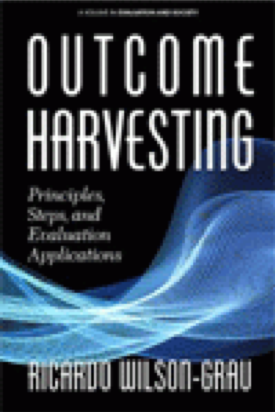Hello! I am Salome Tsereteli-Stephens and I am the deputy director of Research, Evaluation and Learning Division of the American Bar Association Rule of Law Initiative (ABA ROLI). I’ve been fascinated with Outcome Harvesting (OH) for a number of years as it’s a participatory method, particularly well-suited for complex programs and have tried to test it in Rule of Law context as part of a Democracy, Rights and Governance (DRG) portfolio.
 Rad Resource: The author of OH, Ricardo Wilson-Grau, who passed away earlier this year, explains the essence of the method best in a video. For this method, “outcome” is an observable change in the actions, activities, relationships, agendas, policies, or practice of individuals, groups, communities, organizations or institutions. It is particularly appropriate for contexts, where cause and effect are not fully understood during implementation or the context and the intervention changed too fast for evaluation to measure predetermined objectives.
Rad Resource: The author of OH, Ricardo Wilson-Grau, who passed away earlier this year, explains the essence of the method best in a video. For this method, “outcome” is an observable change in the actions, activities, relationships, agendas, policies, or practice of individuals, groups, communities, organizations or institutions. It is particularly appropriate for contexts, where cause and effect are not fully understood during implementation or the context and the intervention changed too fast for evaluation to measure predetermined objectives.
In 2015 I was able to apply it in an internal evaluation of a rule of law program supporting a unified Bar association in Kyrgyzstan. The greatest takeaway from my experience centered on the impact of using the OH on the organizational changes that resulted from the participatory approach. I followed the steps defined by Ricardo and found that it is one of the methods that could be applied in the DRG field. Having the benefit of being an internal evaluator, I was able to continue to observe changes in the program office in months and years following the evaluation. We documented the lessons and included them as an example in Ricardo’s new book Outcome Harvesting Principles, Steps, and Evaluation Applications – in which he provided new insights for anyone interested in taking on this methodology. His book provides invaluable guidance for evaluators interested in pursuing Outcome Harvesting.
Rad Resources:
- For anyone interested in joining evaluators around the world, practicing Outcome Harvesting, there is a vibrant online community.
- Ricardo Wilson-Grau summarized the essence of the approach and provided some rad resources in the AEA blog in 2014.
- Recent report on Ford Foundation’s Strengthening Human Rights Worldwide global initiative applied OH alongside other methods for its learning review and harvested over 1200 outcomes and importantly, validated the Initiative’s hypothesis that actors in the Global South could make a global impact through strengthening their agency and voices for influencing the human rights movement.
- Government of Finland used OH in 2018 to evaluate Improvement of Women’s and Girls’ Rights in Finland’s Development Policy and Cooperation. The evaluation identified results in terms of behavior changes relevant to promotion of rights of women and girls summarizing findings along with a webinar and case studies.
In the last two years, OH has also been employed in evaluation of climate change, agriculture and food security, and disaster risk reduction.
The American Evaluation Association is celebrating Democracy & Governance TIG Week with our colleagues in the Democracy & Governance Topical Interest Group. The contributions all this week to aea365 come from our DG TIG members. Do you have questions, concerns, kudos, or content to extend this aea365 contribution? Please add them in the comments section for this post on theaea365 webpage so that we may enrich our community of practice. Would you like to submit an aea365 Tip? Please send a note of interest to aea365@eval.org. aea365 is sponsored by theAmerican Evaluation Association and provides a Tip-a-Day by and for evaluators.

Thank you, Salome, for this post and useful compilation. Ricardo is greatly missed. I’m very happy to see OH continue, and the method’s benefits to be promoted.